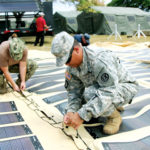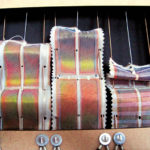Flexible and durable power-generating textiles are poised to make a difference in meeting tomorrow’s energy requirements.
Looking forward, before imagination meets prototype, the next generation of energy-producing products seems unattainable. Looking backward, after such innovations are readily available, the development process seems logical—and simple. It’s the “hindsight is 20/20” phenomenon.
While photovoltaic power-harvesting technologies are not new, the ways in which researchers are manipulating science to meet consumers’ needs are. The most promising energy-harvesting textiles may not have hit the market yet, but the best and brightest researchers are doing what innovators always do—apply imagination to science to bring into reality what once seemed impossible.
In its simplest terms, photovoltaics is a field of semiconductor technology that involves the direct conversion of electromagnetic radiation (sunlight) into electricity. (The concept has been around since the 1950s. Think rigid solar panels.) Although the physics and technologies behind this energy harvesting are not new, the ways in which flexible, durable substrates can facilitate the power are—and commercial products are soon to follow.
Imbedded solar
“In general, photovoltaics as cells have not advanced much in the last 20 years,” says Connie Huffa, president and executive textile engineer for Fabdesigns Inc., Encino, Calif. The company is an engineering laboratory for extreme textile products including film, medical, military and aerospace. “What we are hoping for as an industry is a breakthrough in smaller, more flexible, more productive units that can withstand weather, the elements and potential hazards.”
Currently, the standard for photovoltaic applications depends on depositing the layers of amorphous silicon cell material (a solar semiconductor) onto a thin sheet of plastic and then welding, sewing or laminating the plastic to the textile. Companies such as Power Textiles Ltd., Selkirk, Scotland, are working to directly integrate solar cells into fabric.
“One of the attractions of our approach is that we can lay down silicon at low temperatures as opposed to higher temperatures that are typically used to adhere silicon to film, which can melt or degrade the fabric,” says Robert Mather, executive director of Power Textiles.
“What that means is that we have a way to integrate the cells directly into commodity fibers such as polyester and nylon 6/6, and skip the step of adhering solar cells to film first. But even more important than saving the extra step is preserving the integrity of the fabric. We believe that in a number of cases the property of the fabric is compromised by the presence of the film.”
The technology to integrate solar cells into fabric was developed by John Wilson, professor at Heriot-Watt School of Engineering and Physical Sciences, Edinburgh, U.K. Mather, Wilson and their team of researchers have been able to demonstrate the concept but are still working to increase efficiency to make it commercially viable. Applications for the technology include agriculture, disaster relief, military and architecture.
“One of my hopes is to use the technology for tents and humanitarian purposes,” Mather says. “But that would require more bolt material, which we feel we can do eventually, but initially high-value niche applications are more likely.”
Right now, particularly in Scotland, there is interest in using the technology for soft fruit growers, Mather says. “Incorporating solar panels into polytunnels can enhance the enclosed growing environment through controlling aspects such as airflow, humidity, irrigation or pest control, with the solar electrical energy powering sensors and actuators,” he says.
“There may also be the option of extending the growing season cycle by the introduction of low-level heat, generated by the energy from photovoltaic cells.”
Power Textiles is currently seeking more funding from the Scottish government so it can move from having a demonstrative prototype to a more commercially viable prototype. It expects to bring products to market in approximately a year.
Interwoven solar
Another technology that integrates solar materials into textiles involves optical fibers. An international team of chemists, physicists and engineers, led by John Badding, a professor of chemistry and physics at Penn State University, University Park, Penn., is working on flexible solar materials integrated into silica glass optical fibers that are thinner than human hair and flexible. In essence, the team deposited n-, i-, and p-type silicon into optical fibers to create a solar cell. How this is different from conventional solar cells is that the cells can be woven and are thus flexible and permeable to water vapor and air, just like conventional fabrics.
The group first published its findings in 2012, and since then has been successful in weaving the cells into fabric. “There are different layers of semi-conductor that have been integrated right into the thread of the fabric,” Badding says. “To my knowledge nobody else has ever been able to make a structure like this.”
The team has yet to develop a commercial product from the prototype, but the possibilities for how to use flexible solar textiles include clothing to power personal devices and fabrics for tents.
Badding points out that the military will likely be the first customer for something like this “because they’re willing to pay the higher price to develop it—and then it can develop into civilian applications after that.”
Badding admits there’s a lot of work to be done to move this technology forward, exciting as it is. “One thing we need to work on is making the technology more practical. For instance, we probably want to work with plastic fibers as opposed to glass,” Badding says. “New ideas take a while to get traction, but we’re OK with that. It gives us time to further develop the technology and take the lead in this.”
While flexible and durable solar textile products have yet to make it to the marketplace, advancements are being made, and the core technologies have been developed. With a little more time and funding, there should be commercially viable products in the near future.
 TEXTILES.ORG
TEXTILES.ORG






